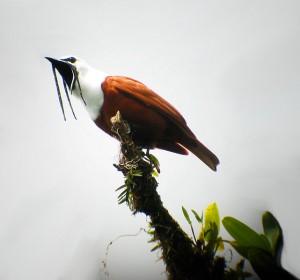Describing Variation in Bird Sounds

Bird sounds vary on many levels. Naturally, they vary from one species to the next. But they can also vary within a species — say, between birds from different geographic regions. And they can also vary within a geographic region — say, between one individual bird and the next. And they can also vary within an individual bird — say, if that individual happens to have a repertoire of multiple songtypes. And they can even vary within one songtype of one individual bird — say, if the bird fails to reproduce that same songtype exactly each time it sings.
When talking about variation, it would be nice to be able to distinguish exactly which kind of variation we mean. I propose a vocabulary like the following.
Differences between individuals: variable vs. uniform
I’ve started using the word variable to describe sounds that show high levels of individual variation, and uniform to describe sounds with low levels of individual variation. In other words, variable sounds differ from one bird to the next; uniform sounds are the same in all members of a species.
Variable sounds (differing between individuals)
A good example of a variable sound is the mewing call of the Spotted Towhee. This sound takes a great many forms across the range of the species. Even in the same location, the calls of different individuals may differ sharply.
Uniform sounds (the same between individuals)
The song of the Chuck-will’s-widow is highly uniform: that is, it varies little across the entire geographic range of the species. If you’ve heard one Chuck-will’s-widow, you’ve pretty much heard ’em all.
Differences within individuals: Plastic vs. stereotyped
Plastic sounds differ slightly each time they are produced, even by the same bird. Stereotyped sounds are always the same when made by the same bird.
Plastic songs are typical of young birds, but some sounds of certain species remain plastic into adulthood, like the “Vreet” call of the House Finch. In adult birds, plasticity may vary with situation and season. Highly stereotyped versions of song tend to be associated with courtship. Plastic versions may be heard in winter, when levels of breeding hormones are lower.
Plastic sounds (differing within individuals)
Notice how these calls are almost never the same twice:
Stereotyped sounds (the same within individuals)
Most bird songs are stereotyped, at least during the breeding season: each time the individual repeats a given songtype, it produces a precise copy of the previous rendition. Note that sounds can be variable and still stereotyped; Eastern Meadowlark songs vary greatly across their range, and even within individuals (in the sense that each individual has multiple songtypes). But consecutive renditions of the same songtype tend to be identical down to the smallest details — the songtype never changes when the same bird repeats it.
The four vocabulary words I’ve defined here (variable, uniform, plastic, stereotyped) aren’t quite sufficient to describe all the different types of variation. Things get complicated when you start talking about repertoires of songtypes, truncations of stereotyped songs, or mosaics of geographic variation of different song features. But maybe this is a start. I’ll be happy to hear what people think.